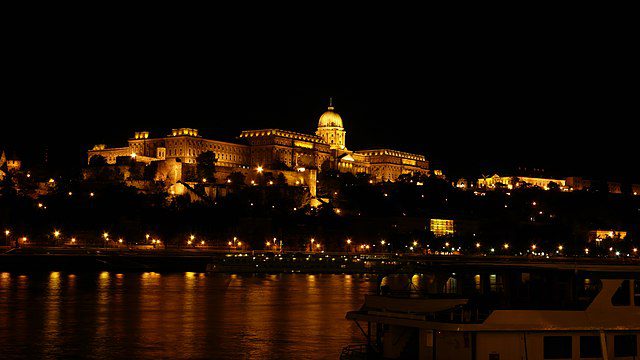
20190502 View of Buda Castle from Gellért Hill 1636 2135 DxO-by Jakub Hałun-Wikimedia Commons
A Brief History of the Buda Castle
Buda, the historical core of a city with a complex and varied past, is home to some of Europe’s most impressive structures as well as an enviable natural setting with breathtaking Danube views. Buda Castle is a magnificent fortress that represents Budapest and Hungary. The Hungarian Kings’ stronghold and imperial house, which once served as a means of policing Budapest as a whole, stood tall and imposing. This opulent Castle, which was first built in the magnificent year 1265, is one of the most well-known palaces. The enormous building was originally known as the Royal Palace since the Imperial Family lived there. Knowing that this location is one of the most renowned UNESCO World Heritage Sites on the European continent helps one understand the enormous significance and magnificence of this Castle. Here is a brief history of Buda Castle.
Read more on some of theTop 10 Facts about the Buda Castle in Budapest.
History

Buda Castle rising sun 2021-by VargaA-Wikimedia Commons
The royal palace is another name for the Buda Castle. This is due to the fact that some of Hungary’s kings resided in this palace. The monarch Matthias Corvinus was one among them ( known from the Matthias Church). He gave the castle a Renaissance makeover, which helped popularize the look throughout Hungary. Except for a few of the walls that are still standing, the castle you can see when you are on top of the 70-meter-high hill is not at all the original. In truth, the castle that once stood here has been repeatedly demolished and rebuilt. The building was completely destroyed during World War II, which was the most recent and devastating catastrophe. Only one hall remained intact. However, the Hungarians also succeeded in rebuilding a few more halls from the ruins that were still there. The structure was fully restored to its former splendor in 1970.
Destruction of the medieval castle

20190502 Buda Castle Budapest 1101 2028 DxO-by Jakub Hałun-Wikimedia Commons
When Buda was taken by allied Christian soldiers during the great siege of 1686, the medieval palace was destroyed. Two years after Buda’s unsuccessful siege, in 1686, a second Christian Western European campaign to conquer the city was launched. There was a massive artillery barrage that caused numerous structures to burn and fall. The Stephen’s Tower, which the Ottomans employed as a gunpowder storage facility, was destroyed when a single cannon, allegedly fired by a friar by the name of Gábor (also known as Tüzes Gábor), struck it (“Gabriel Fiery”). The explosion reportedly resulted in up to 1,500 Turkish soldiers dying, and it also generated a wave on the Danube that washed away artillery batteries and guards stationed on the opposing shore.
Although the walls were mostly still standing, the burned-out shell quickly deteriorated due to a lack of upkeep. Stephen’s Tower completely vanished between 1702 and 1715, and the palace was beyond restoration. The Broken Tower and the palace’s main structure were completely destroyed, the hollows and moats were filled, and a new level terrace was built. A mountain of trash and earth covered the southern fortifications, zwingers, and rooms.
Find out more about the castle in this free tour.
Early Baroque palace
A tiny Baroque palace was created in 1715 using Johann Hölbling’s plans. It was a straightforward rectangular structure with an interior court and a smaller side wing that was eventually torn down. The core of the current palace, which houses the Baroque Court of the Budapest Historical Museum, is identical to that of the Hölbling mansion. After the palace accidentally caught fire in 1723, the windows were blocked up to prevent additional damage. The incomplete, deteriorating shell of the straightforward two-story blockhouse is seen in a number of artworks from the 1730s and 1740s. Some engravings depict a perfected finished product that didn’t exist. The roof was fixed sometime around 1730.
Interbellum years and World War II
The Hauszmann palace was in use for about 30 years, and on December 30, 1916, it participated in the coronation of Charles IV of Hungary, the final Hungarian king. The palace served as the hub of social and political activity in Hungary throughout this time. King Victor Emmanuel III of Italy and Cardinal Eugenio Pacelli (later Pope Pius XII) were two notable visitors Horthy entertained in the castle in 1937 and 1938, respectively. On February 11, 1945, the German and Hungarian forces defending the fortress made an unsuccessful attempt to breach the Soviet siege.
They said that the Soviet Red Army was aware of their preparations and had spent hours before aiming heavy weapons at potential escape routes. This is regarded as one of the greatest military mishaps in Hungarian history. The palace was reduced to ruins by fierce battles and artillery fire. Roofs and vaults collapsed, furnishings disappeared, and the southern and western wings caught fire. The level of destruction was similar to that of the prolonged siege in 1686.
Reconstruction

Buda castle – panoramio-by Paulo Cerqueira-Wikimedia Commons
Archeological exploration was started right after the war to find the castle’s medieval remnants. László Ger wrote the initial reconstruction plan for the medieval ruins in 1950, and it was completed in 1952. In 1966, the reconstruction process was complete. The entire medieval fortification system was recreated, defying known theories of historical reconstruction. Important structures including the Great Rondella from the 16th century and the medieval Gatehouse, the Mace Tower, the walls, and the zwingers were rebuilt in accordance with the findings of the archaeological investigation and visual evidence from the time.
Along with the domed Gothic Hall and the Lower Church of the former Royal Chapel, the low-lying southern wing of the Gothic palace was also rebuilt. In the zwingers, gardens in the medieval style were developed. Under the direction of László Zolnay, archeological work on the palace’s northern and western sides proceeded in the 1970s. The Late Gothic Buda Castle Statues are among its many notable accomplishments.
Book a free tour of the Buda Castle here.
Tunnels under the Royal Palace
The tunnels beneath Buda Castle are another area that cannot be seen simply by looking at it. A complex tunnel network with hiding spots was constructed underneath the castle since it was also used to defend the city. It is rumoured to be 10,000 meters long. However, some historians contend that nature, rather not human activity, created the tunnels. In any case, they were helpful to all of the castle’s residents.
Check out these 30 Amazing Things to do in Budapest.
Current use Buda Castle
The castle now serves as a venue for cultural events. In addition to the National Széchényi Library, it also houses the National Gallery and Budapest History Museum. So, choose one of these three locations if you wish to visit the castle.
Hungarian National Gallery

Hungarian National Gallery interior-by Takkk (Takács István)-Wikimedia Commons
This national gallery, located inside the castle, showcases and chronicles Hungary’s growth in the fine arts. Around 10,000 works of art by Hungarian artists, dating from 1800 to 1945, can be found here, among others. Along with Hungarian sculpture, the collection includes coins, medals, and plaques by Hungarian masters. There is also a collection of prints and drawings by Hungarian artists, as well as a modern collection that includes works by Hungarian artists from 1945 to the present. The Hungarian National Gallery also hosts some really fascinating temporary exhibitions in addition to the permanent ones. For information on current exhibitions, see their website.
Budapest History Museum
The Aquincum Museum, the Castle Museum, the Kiscell Museum, and the Budapest Gallery are the three distinct museums that make up the Budapest History Museum. However, the Castle Museum is the sole museum housed within Buda Castle. It illustrates Budapest’s tumultuous past two millennia. Additionally, there are a few sculptures and some of the palace’s reconstructions here. Visit their website for more details about the museum.
National Szechenyi Library

National Széchényi Library-by Országos Széchényi Könyvtár-Wikimedia Commons
This library, which is located in Buda Castle, aims to preserve and make accessible to the general public traditional and contemporary library materials of the Hungarian cultural heritage. This is the location for you if you prefer to study or look for a calm area. Other than that, it isn’t very noteworthy. Visit their website to view the opening times and other details.
Read more on 5 Unmissable Bookstores in Budapest.
How to get to Buda Castle
From Deak Ferenc Ter: Take bus number 16, 16A, or 116 from Deak Ferenc Ter. At the end of the chain bridge, exit at Clark Adam Square. You have two options for getting there: on foot or by elevator. During the day, they show up around every five minutes. The Castle Hill Funicular is another option.
From Ferenciek tere: Take the 5 or 178 bus. After getting off at the Dózsa György tér, ascend the stairs until you reach the base of the castle wall.
On foot: Wander over to the castle hill from the city’s Pest side. When you get to the bottom, you can either take the steps or the pathway. You could also ride the funicular up.
Planning a trip to Paris ? Get ready !
These are Amazon’s best-selling travel products that you may need for coming to Paris.
Bookstore
- The best travel book : Rick Steves – Paris 2023 – Learn more here
- Fodor’s Paris 2024 – Learn more here
Travel Gear
- Venture Pal Lightweight Backpack – Learn more here
- Samsonite Winfield 2 28″ Luggage – Learn more here
- Swig Savvy’s Stainless Steel Insulated Water Bottle – Learn more here
Check Amazon’s best-seller list for the most popular travel accessories. We sometimes read this list just to find out what new travel products people are buying.










